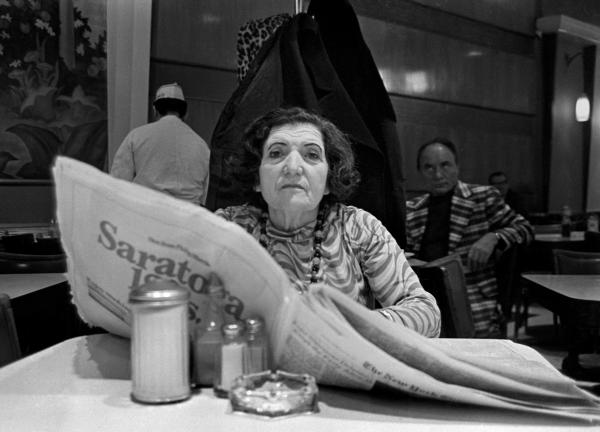The streets of New York City were filled with hundreds of cafeterias, self-service eating establishments, during the early to mid-20th Century. Their growth paralleled the rise of the office worker, women’s evolving roles in the work force, immigration, American love of efficiency and novelty, the growth of cities, the impact of Prohibition and the Depression, the labor movement, and American eating habits. Not one cafeteria from that era remains in New York City today. One particular restaurant, Dubrow’s Cafeteria in Brooklyn, was a legendary institution that served as a second home for many of the neighborhood’s elderly residents. Along with another Dubrow’s, a hub of the Garment Center, they provided a restaurant cum social club or “third place” for a generation of Jewish New Yorkers.
New York City-based photographer Marcia Bricker Halperin documented Dubrow’s and other cafeterias in their waning days, drawn to the memorable faces and the liveliness and sorrow of urban life in that vanished world.
There is both an accessible elevator and gender-neutral restroom on the first and second floor. If you have a disability that requires an accommodation, contact judaicstudies@umich.edu or 734-763-9047.
New York City-based photographer Marcia Bricker Halperin documented Dubrow’s and other cafeterias in their waning days, drawn to the memorable faces and the liveliness and sorrow of urban life in that vanished world.
There is both an accessible elevator and gender-neutral restroom on the first and second floor. If you have a disability that requires an accommodation, contact judaicstudies@umich.edu or 734-763-9047.
| Building: | 202 S. Thayer |
|---|---|
| Event Type: | Lecture / Discussion |
| Tags: | Jewish Studies, photography |
| Source: | Happening @ Michigan from Judaic Studies, Institute for Research on Women and Gender, Women's and Gender Studies Department, Eisenberg Institute for Historical Studies, Department of American Culture |


